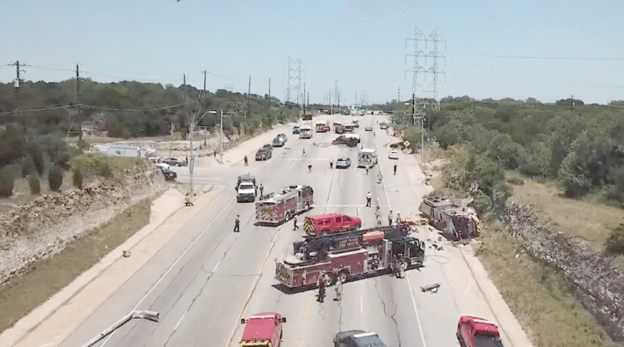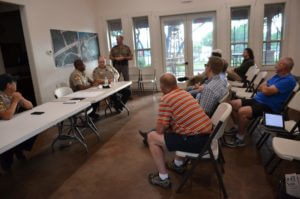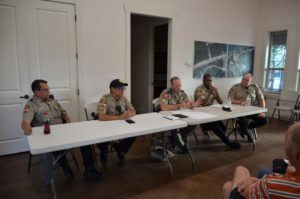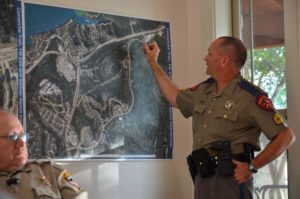
Ryan McKittrick, Texas Highway Patrol sergeant, recapped the May 16 accident at the Steiner Ranch Neighborhood Association meeting on June 18. Usually an accident is cleared in a couple of hours but this one lasted 8 hours because it was so complex.
SRNA hosts officials
By LYNETTE HAALAND, Four Points News
Officers from Travis County Sheriff’s Office and Texas Department of Public Safety were at last week’s Steiner Ranch Neighborhood Association meeting to explain how they handled the five-vehicle accident on May 16 that affected thousands of local residents over 8 hours.
Law enforcement officials said that this was one of the biggest accidents that the county has ever had.
This was one of the biggest and most complex scenes in Travis County on record, said Frank Lofton, Travis County Sheriff’s lieutenant.
“There were so many moving parts. Our first priority is to preserve life and second is to treat the area like a crime scene,” said Ryan McKittrick, Texas Highway Patrol sergeant.
On May 16 around 1:45 p.m., a Lake Travis Fire Rescue engine was returning to Fire Station 604 at 5939 Comanche Trail with four firefighters when it left its lane and crossed over the center of RM 620, hitting four vehicles before hitting a traffic light pole, sending the pole and wires onto the road. The truck came to a stop when it flipped over, McKittrick said.
“The driver of the truck was unresponsive. The truck was clipping vehicles in the northbound lane,” he said. Another LTFR firefighter tried to take the wheel but could not get it in time and knew he better seatbelt up to protect himself from impact, McKittrick said.
“When the fire truck came to rest, the crew got out of the truck to check everyone out,” McKittrick said. “One car was in flames.”
Later it was released that LTFR engineer William Tatsch lost consciousness while driving the fire engine and suffered “an extremely rare case of a presumed vasovagal syncope” which caused the accident.
There were no reported deaths from the accident. The accident sent 10 out of the 12 people involved to area hospitals. One victim was flown to hospital and all others were transported on the ground.
STAR Flight had trouble landing at the scene because of at least one personal drone that was flying in the area. Seconds matter in emergency situations and a drone, if caught in the helicopter, can damage it while trying to land, McKittrick said.
As soon as Travis County Sheriff’s Office got onto the scene, officers diverted traffic.
“On a good day 620 traffic is bad. With redirecting, there was no other possible route around 620 than through Steiner,” McKittrick said.
Making the scene even more challenging, some motorists ran out of gas while inching forward in the long traffic lines that night. Some Steiner residents started walking home from the Oasis on Lake Travis area, since Comanche Trail was closed for many hours.
One attendee at Monday night’s SRNA meeting questioned why RM 620 was not opened sooner?
Law enforcement on the scene did not open RM 620 sooner to keep officers and drivers safe.
The crash took out a traffic pole that made the scene more difficult, and to give some idea, the bolts that held the traffic light in place were 2 to 3 inches in diameter, McKittrick said. The pole had to be reset.
“It (the down light pole) was the big thing in this collision scene and caused delays in opening the road,” he said.
There was debris on both sides of the road and no traffic control. The traffic pole on the ground and the fire truck had to be moved. Crews had to wait for the heavy wreckers to do that, McKittrick said.
In addition to the wreckage from the five vehicles, there were live wires on ground and poles, said Don Rios, Travis County Sheriff’s sergeant.
Comanche Trail was blocked to help officers work the situation. Fixing the light took three different bucket trailers going up, Rios said.
“At one point, we got the lights running. They were flashing… but only 25 percent of the drivers were stopping. We almost had numerous accidents,” Rios said.
So the decision was made to keep both officers and drivers safe rather than keep RM 620 open near the scene.
It was not prudent to put officers out there in harm’s way with the steep grade in the road that is hard for drivers to see and the other dangers surrounding the night, Rio said.
“It was a lot more complicated than it seems,” Rios said. “The bottom line it comes down to is that a decision had to be made, it was a life and death situation (to work the scene). We chose to error on the side of safety.”
While some officers were working the scene, another was writing the crash report, and others were using laser radar and taking photos of the scene for the investigation. It was easier to do this with the wreckage still on the road before the wreckers took the pieces away, McKittrick said.
When the accident was debriefed, one thought was to put an officer at Quinlan Park Road and Steiner Ranch Boulevard since traffic was being detoured through Steiner. But the departments did not have enough manpower to spare. Also there was a suggestion of putting a sign there to show which direction headed back out of Steiner but there was not time to get that set up either.
To make matters worse, there was a major collision on Bee Cave Road at the same time which affected many going home from work or practices who were trying to re-route in that direction.
“It was a worse-case scenario. There are only four or five main roads (in this portion of the county): 620, 71, Bee Cave, 290. When one goes down that’s bad. When two of those major roads go down, you have to wait in the gridlock,” McKittrick said.
The departments working the scene also experienced manpower challenges because a dive team was dispatched to cover a drowning at Lake Pflugerville.
Austin Police Department provided little back up because they were working their calls.
Rios said he, like other officers, lost 5 pounds working the accident in the 100 degree weather on the hot pavement in the heavy uniforms they wear.
Fortunately, Lofton said, there were extra officers available to work the accident because the timing of the accident happened during the shift change.
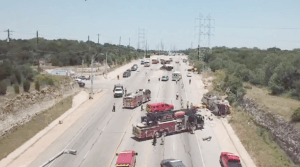
The five-vehicle accident on RM 620 near Comanche Trail on May 16 was one of the most complex Travis County has ever had. For 8 hours, it affected thousands of local residents.
Courtesy Ammon Covino/KVUE

